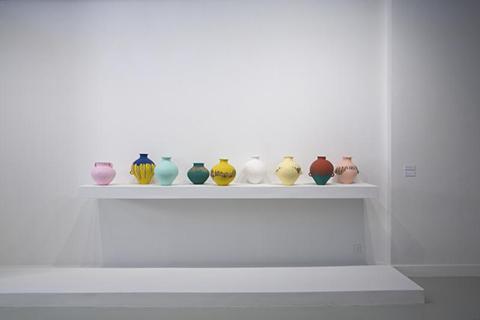‘Dropping the Urn’ Curators Look Back on Groundbreaking Ai Weiwei Exhibition

“It’s so interesting that you can think of a ceramic exhibition as risky, because it’s a very comfortable medium,” said Gregg Moore, who pitched the idea of curating an exhibition of ceramic works by Chinese artist and dissident Ai Weiwei to Richard Torchia, Director of the Arcadia University Art Gallery, in the fall of 2009. As with the show that evolved out of their initial conversation (and a three-week proposal writing frenzy), context is everything.
Sitting down with Dr. John Noakes to discuss curating Ai Weiwei: Dropping the Urn (Ceramic Works, 5000 BCE – 2010 CE), Moore and Torchia revealed that they scheduled the exhibition to coincide with the spring conference of the National Council on Education for the Ceramic Arts (NCECA), which convened in Philadelphia, Pa., in March 2010. By introducing this community to the work of a conceptual artist whose practice includes using ancient urns as ready-mades (see: “Dropping a Han Dynasty Urn,” a photo-triptych depicting the destruction of an antique vase), the curators were taking a huge risk.
“The thing I enjoyed about Gregg’s suggestion, by agreeing to show this work, it was almost literally like bringing the bull into the china shop, because [Ai Weiwei] actually has said that he hates ceramics,” said Torchia. “Here’s an artist who works with clay but never touches it, and so the conceptual dynamic of bringing an artist who could be identified as so associated with that history but at the same time [is] so critical of it was really exciting.”
Ai’s entire practice includes everything from architecture to fashion photography. In narrowing the scope of the exhibition to Ai’s use of ceramic pieces as ready-mades, Moore and Torchia intended to demonstrate how the selected pieces were essential to understanding all of Ai’s other work. “I think that was why the show registered so deeply with the other audiences that came in that weren’t necessarily of the ceramic world but people who were interested in the precedence of Duchamp and the found object and the sort of activism that is always in the work,” said Torchia.
 The exhibition included “Dropping a Han-Dynasty Urn,” 1995, a triptych of gelatin silver prints. View the exhibition’s annotated checklist.
The exhibition included “Dropping a Han-Dynasty Urn,” 1995, a triptych of gelatin silver prints. View the exhibition’s annotated checklist.Moore added, “I really wanted to put something together that was different than the exhibitions that are mounted during NCECA, which really celebrate American ceramic culture; and very few people in my field knew, maybe still [don’t] know, about Ai Weiwei, because he doesn’t work in the field of ceramics.
“The meaning behind his work is so deep and embedded in Chinese history and culture that as conceptual works of art they’re really quite strong, and my field, the field of ceramics, really owes a great debt of gratitude to Chinese ceramic history, and yet somebody so important who is using this material for his work hadn’t really been discovered yet.”
Today, it’s apparent that the risk was well worth it. Since Ai Weiwei: Dropping the Urn was exhibited at Arcadia University Art Gallery, it has traveled to the Museum of Contemporary Craft in Portland, Ore., and to the Victoria and Albert Museum in London, England, garnering rave reviews. In addition, Moore and Torchia published a fully illustrated catalog featuring four essays commissioned for the exhibition and appearing both in English and in Chinese translation.


